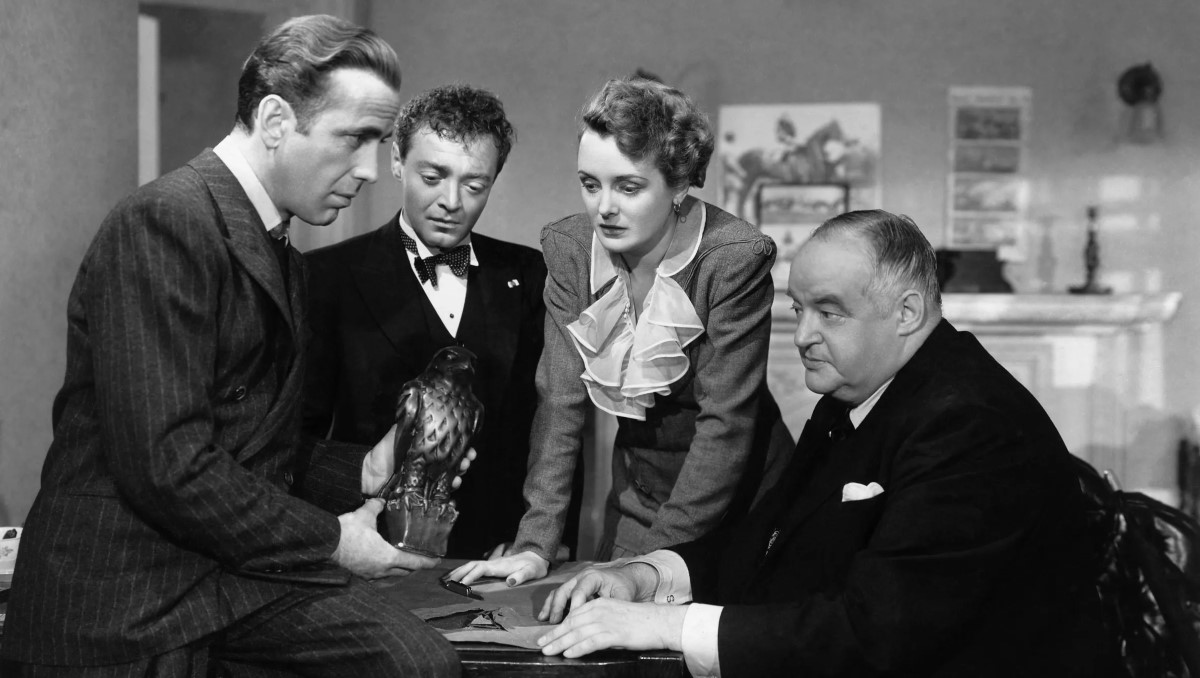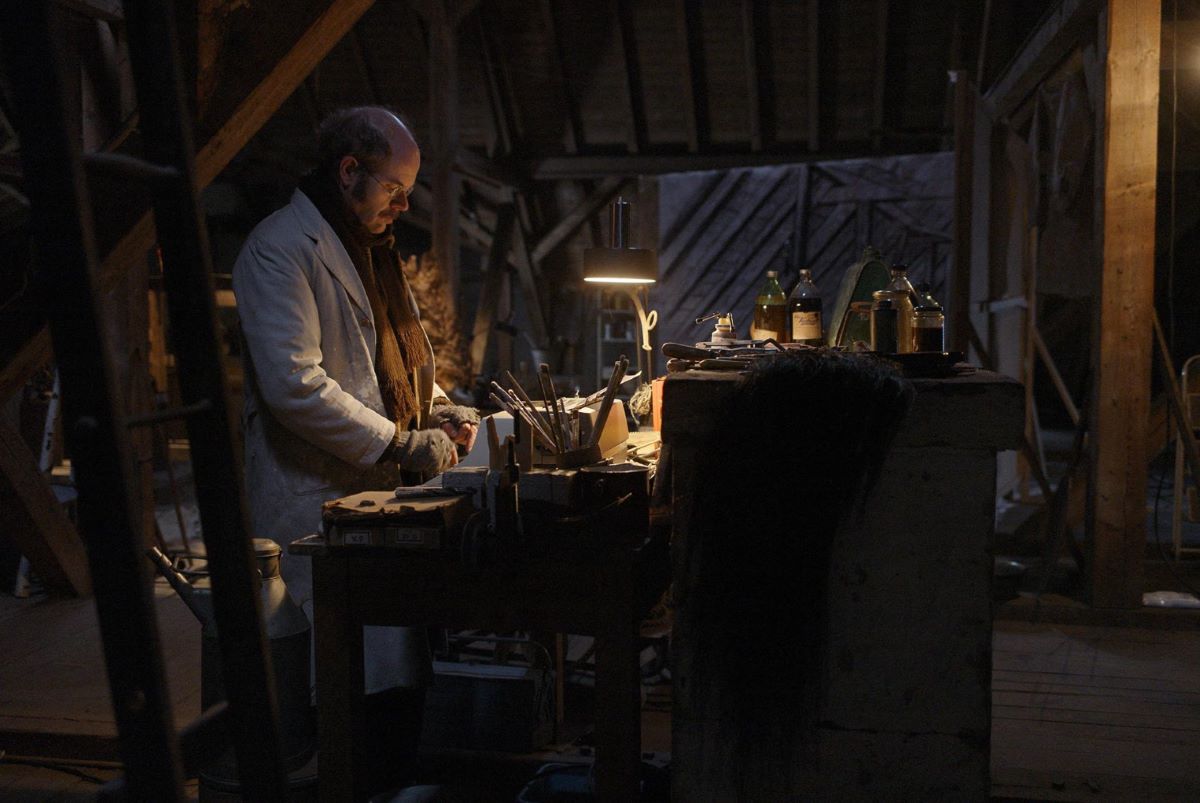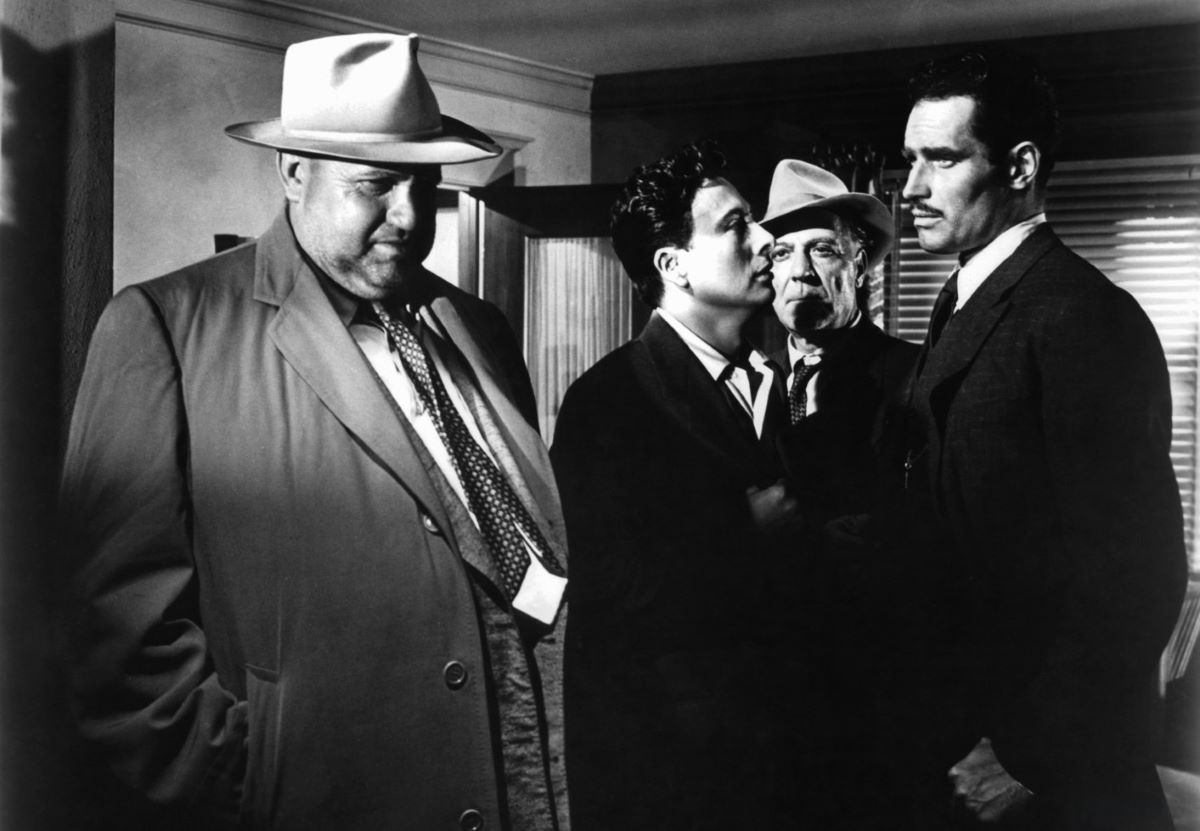Running Time: 101 minutes
Certificate: PG
* * *
The Maltese Falcon, a Fast Mystery-Thriller With Quality and Charm, at the Strand
The Warners have been strangely bashful about their new mystery film, The Maltese Falcon, and about the young man, John Huston, whose first directorial job it is. Maybe they thought it best to bring both along under wraps, seeing as how the picture is a remake of an old Dashiell Hammett yarn done ten years ago, and Mr. Huston is a fledgling whose previous efforts have been devoted to writing scripts. And maybe—which is somehow more likely—they wanted to give every one a nice surprise. For The Maltese Falcon, which swooped down onto the screen of the Strand yesterday, only turns out to be the best mystery thriller of the year, and young Mr. Huston gives promise of becoming one of the smartest directors in the field. For some reason, Hollywood has neglected the sophisticated crime film of late, and England, for reasons which are obvious, hasn’t been sending her quota in recent months. In fact, we had almost forgotten how devilishly delightful such films can be when done with taste and understanding and a feeling for the fine line of suspense. But now, with The Maltese Falcon, the Warners and Mr. Huston give us again something of the old thrill we got from Alfred Hitchcock‘s brilliant melodramas or from The Thin Man before he died of hunger. This is not to imply, however, that Mr. Huston has imitated any one. He has worked out his own style, which is brisk and supremely hardboiled. We didn’t see the first Falcon, which had Ricardo Cortez and Bebe Daniels in its cast. But we’ll wager it wasn’t half as tough nor half as flavored with idioms as is this present version, in which Humphrey Bogart hits his peak. For the trick which Mr. Huston has pulled is a combination of American ruggedness with the suavity of the English crime school—a blend of mind and muscle—plus a slight touch of pathos. Perhaps you know the story (it was one of Mr. Hammett’s best): of a private detective in San Francisco who becomes involved through a beautiful but evasive dame in a complicated plot to gain possession of a fabulous jeweled statuette. As Mr. Huston has adapted it, the mystery is as thick as a wall and the facts are completely obscure as the picture gets under way. But slowly the bits fall together, the complications draw out and a monstrous but logical intrigue of international proportions is revealed. Much of the quality of the picture lies in its excellent revelation of character. Mr. Bogart is a shrewd, tough detective with a mind that cuts like a blade, a temperament that sometimes betrays him, and a code of morals which is coolly cynical. Mary Astor is well nigh perfect as the beautiful woman whose cupidity is forever to be suspect. Sidney Greenstreet, from the Theatre Guild’s roster, is magnificent as a cultivated English crook, and Peter Lorre, Elisha Cook Jr., Lee Patrick, Barton Mac-Lane all contribute stunning characters. (Also, if you look closely, you’ll see Walter Huston, John’s father, in a bit part.) Don’t miss The Maltese Falcon if your taste is for mystery fare. It’s the slickest exercise in cerebration that has hit the screen in many months, and it is also one of the most compelling nervous-laughter provokers yet.
The New York Times, October 4, 1941
* * *
Sam Spade, a private detective, gets involved in a murderous hunt for a valuable statuette.
by Simon Braud
As one of the two dizzying peaks of the private eye genre (although whether it is Everest to The Big Sleep’s K2 is open to debate), The Maltese Falcon is an unassailable triumph of script, casting, direction and editing. As an example of ensemble acting it takes some beating too. It put John Huston on the map as a writer-director — his debut in both disciplines — and finally furnished Bogart, who once joked bitterly that he’s made a career out of playing George Raft’s brother-in-law, with a showcase for his great talent and superhuman on-screen charisma. In the role of Sam Spade he stepped smartly off the B-movie treadmill that a spiteful Jack Warner, incensed at the actor’s contractual grievances, had tied him to. And with Casablanca (1942), The Big Sleep (1946), The Treasure of the Sierra Madre (1948) and The African Queen (1951) waiting in the wings this was a legend in the making. And Raft must have been killing himself. He had originally been offered the role but turned it down.
There’s no doubt that Bogart, who appears in almost every scene, dominates the film. But he’s surrounded by a cast of supporting players that any actor would die for — Mary Astor as the wide-eyed and deadly Brigid O’Shaugnessy (aka Ruth Wonderly), Peter Lorre as the effeminate, fastidious Joel Cairo; Sydney Greenstreet as the avuncular, yet sinister, fat man, Kasper Gutman. Even the minor roles are cast to perfection — Lee Patrick as Effie Perrne, Spade’s secretary-factotum; Jerome Cowan as his partner Miles Archer; Ward Bond and Barton MacLane as a pair of lumbering flatfoots; Gladys George as Archer’s widow; and Elisha Cooke Jr., brilliant as the teenage gunsel Wilmer. It’s a fabulous, motley collection of characters. And superbly played though they are, credit for their creation must be given to Dashiell Hammett from whose novel the film was adapted.
A one-time operative for Pinkerton’s Detective agency, Hammett based each one on somebody he had known in real life. Brigid O’Shaugnessy was based partly on his secretary, a Miss Peggy O’Toole, and partly on a woman who once employed him to fire her housekeeper. Joel Cairo’s exotic real-life counterpart was a man Hammett picked up on a forgery charge in 1920. Wilmer, the boy gunman, was drawn from a baby-faced petty criminal known in Stockton, California, as “The Midget Bandit”. Casper Gutman, Hammett once recalled, was based on,“Someone suspected of being a German secret agent” whom he had shadowed in Washington while working for Pinkerton’s.
It’s widely held that Sam Spade was, to some extent, autobiographical. Hammett, though, was quick to deny the assertion. “He’s a dream man,” he remarked in 1934, “in the sense that he is what most of the detectives I worked with would like to have been and what quite a few of them, in their cockier moments, thought they approached… A hard and shifty fellow, able to take care of himself in any situation, able to get the best of anybody he comes in contact with, whether criminal, innocent bystander or client.” Writer William F. Nolan put it succinctly when he said, “Samuel Spade is of course a direct extension of the author, a man caught up in an unstable universe of random violence who survives by following a rigid self-imposed code of honour.” Either way, Spade is both the template for every movie PI who followed — including Marlowe — and the epitome of Bogart’s screen persona.
Critic Andrew Sarris, in a rare moment of idiocy, claimed that Huston’s films, “Owe more to casting coups than directorial acumen,” and disparaged Falcon as, “An uncanny match up of Dashiell Hammett’s literary characters with their visual doubles.” The former assertion is nonsense and the latter, since the book describes Spade as resembling a “blonde Satan”, demonstrably not true.
Huston’s script owes a great deal to Hammett, but transposing the author’s gripping prose to the screen was no picnic. After all it had been bodged before: in Roy Del Ruth’s 1931 version and in William Dieterle’s Satan Met a Lady (1936), which not even the presence of Bette Davis could salvage. In fact, it’s cause for celebration that both the labyrinthine plot and Hammett’s dialogue, which still quivers with racy innuendo, tough talk and pithy one-liners, survive intact. Virtually every scene is a classic, but a perennial favourite is the confrontation between Spade and Gutman where Spade calls the fat man’s bluff, barking ultimatums at him and smashing his whiskey glass on the floor. Spade storms out of the room. As he walks towards the elevator, his face emerges from the shadow of his hat brim. He’s grinning broadly, but when he looks down at his hands, they’re shaking.
A succinct summary of the plot is a tall order — it’s insanely complex, although unlike The Big Sleep it actually does make makes sense. But one of the ultimate joys of the movie is that its de rigeur web of intrigue, double-cross and murder, is spun by a fantastically imaginative device. And again, it’s all due to Hammett’s genius for merging fact with fiction. According to the film, the eponymous falcon was a present from the Order of the Hospitallers of St. John of Jerusalem to King Charles V of Spain. In 1530, Charles had bequeathed the island of Malta to the order and had asked in return for the annual payment of a bird of prey. The crusaders were so grateful that instead they sent a, “Glorious golden falcon, encrusted from head to foot with the finest jewels in their coffers.” But the galleon carrying the prize was plundered and the falcon disappeared. Resurfacing at various intervals thereafter, the bird finally ends up in San Francisco where Gutman, Cairo and O’Shaugnessy are desperate to get their hands on it.
There actually was an arrangement made in 1530 whereby a Maltese bird of prey was presented to Charles V as rent on the island of Malta, but the payments were always living birds. Hammett though, invests his McGuffin with not only a whiff of history but also of romance, danger and mystery. The falcon fuels his characters’ obsession in a way that mere money never could and the spell the falcon casts over everyone involved is what makes the whole movie tick. Not even the impenetrable Sam Spade, who delivers the last line before the fade, is immune. “Heavy, what is it?” asks Detective Polhaus. “The, uh, stuff that dreams are made of,” he replies.
Thoroughly engaging and thought provoking detective movie with a knock-out central performance from Bogart.
Empire, 1 January 2000





